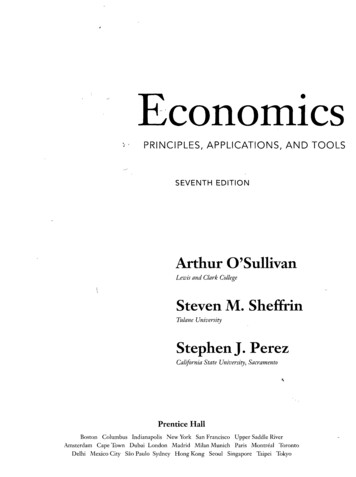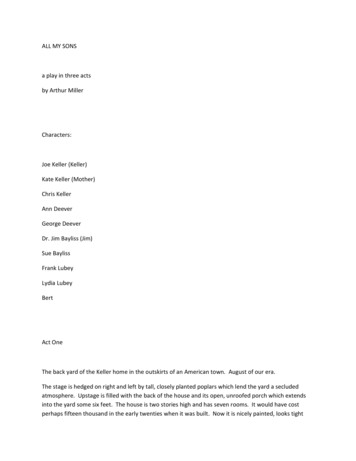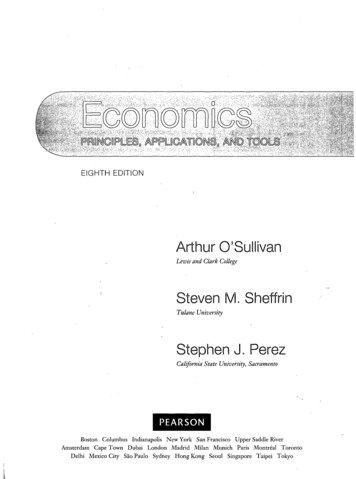
Transcription
0EIGHTH EDITIONArthur O'SullivanLewis and Clark CollegeSteven M. SheffrinTulane UniversityStephen J. PerezCalifornia State University, SacramentoPEARSONBoston Columbus Indianapolis New York San Francisco Upper Saddle RiverAmsterdam Cape Town Dubai London Madrid Milan Munich Paris Montreal TorontoDelhi Mexico City Sao Paulo Sydney Hong Kong Seoul Singapore Taipei Tokyo
ContentsPreface xxxivPART1Introduction and Key PrinciplesPreview of Coming Attractions:Macroeconomics 10Using Macroeconomics to Understand WhyEconomies Grow 11Using Macroeconomics to Understand EconomicFluctuations 11Introduction: What Is Economics? 1Using Macroeconomics to Make InformedBusiness Decisions 11What Is Economics 2Positive versus Normative Analysis 3Preview of Coming Attractions:Microeconomics 12The Three Key Economic Questions: What,How, and Who? 4Using Microeconomics to Understand Marketsand Predict Changes 12Economic Models 4Using Microeconomics to Make Personal andManagerial Decisions 12Economic Analysis and Modern Problems 5Economic View of Traffic Congestion 5Economic View of Poverty in Africa 5Economic View of the Current WorldRecession 6The Economic Way of Thinking 7Using Microeconomics to Evaluate PublicPolicies 12* SUMMARY 13 * KEY TERMS 13* EXERCISES 13APPENDIX: Using Graphs and Percentages 15USING GRAPHS 15Use Assumptions to Simplify 7COMPUTING PERCENTAGE CHANGES AND USINGEQUATIONS 23Isolate Variables—Ceteris Paribus 7APPLICATION 3 The Perils of Percentages 24Think at the Margin 8Rational People Respond to Incentives 8APPLICATION 1 Incentives to Buy Hybrid Vehicles 9Example: London Addresses Its CongestionProblem 9APPLICATION 2 The Economic Solutionto Spam 10The Key Principles of Economics 28The Principle of Opportunity Cost 29The Cost of College 29The Cost of Military Spending 30Opportunity Cost and the Production PossibilitiesCurve 31XIII
civAPPLICATION 1 Don't Forget the Costs of Time andInvested Funds 33The Marginal Principle 33How Many Movie Sequels? 34Renting College Facilities 35The Division of Labor and Exchange 53Comparative Advantage and InternationalTrade 53Outsourcing 54Automobile Emissions Standards 35APPLICATION 1 Absolute Disadvantage andComparative Advantage in Latvia 55Driving Speed and Safety 36Markets 55APPLICATION 2 How Fast to Sail? 36Virtues of Markets 56The Principle of Voluntary Exchange 37The Role of Entrepreneurs 58Exchange and Markets 3 7Online Games and Market Exchange 38Example of the Emergence of Markets:POW Camps 58APPLICATION 2 The Market for Meteorites 59APPLICATION 3 Jasper Johns andHousepainting 38Market Failure and the Role ofGovernment, 59The Principle of Diminishing Returns 39Government Enforces the Rules of Exchange 60APPLICATION 4 Fertilizer and Crop Yields 40The Real-Nominal Principle 40The Design of Public Programs 41The Value of the Minimum Wage 41APPLICATION 5 Repaying Student Loans 42Government Can Reduce EconomicUncertainty 61APPLICATION 3 Civil Liberties and Efficiency ofGovernment 62* SUMMARY 62 * KEY TERMS 63* EXERCISES 63* SUMMARY 43 * KEY TERMS 43* EXERCISES 43* ECONOMIC EXPERIMENT 47Exchange and Markets 49Comparative Advantage and Exchange 50Specialization and the Gains from Trade 50Comparative Advantage versus AbsoluteAdvantage 524 j Demand, Supply, and MarketEquilibrium 67The Demand Curve 68The Individual Demand Curve and the Law ofvDemand 68From Individual Demand to Market Demand 70APPLICATION 1 Law of Demand and Cigarettes 71
XVThe Supply Curve 71The Individual Supply Curve and the Law ofSupply 72Why Is the Individual Supply Curve PositivelySloped? 73A Decrease in Supply Increases the EquilibriumPrice 87Simultaneous Changes in Demand and Supply 87APPLICATION 5 Honeybees and the Price ofIce Cream 89From Individual Supply to Market Supply 74Why Is the Market Supply Curve PositivelySloped? 75APPLICATION 2 Law of Supply and Woolympics 76Market Equilibrium: Bringing Demand andSupply Together 76Predicting and Explaining MarketChanges 90APPLICATION 6 Why Lower Drug Prices? 90* SUMMARY 91 * KEY TERMS 91* EXERCISES 91* ECONOMIC EXPERIMENT 96Excess Demand Causes the Price to Rise 76Excess Supply Causes the Price to Drop 77APPLICATION 3 Shrinking Wine Lakes 78PART 2 [The Basic Concepts in Macroeconomics)Market Effects of Changes in Demand 78Change in Quantity Demanded versus Change inDemand 78Increases in Demand Shift the Demand Curve 79Decreases in Demand Shift the Demand Curve 81A Decrease in Demand Decreases the EquilibriumPrice 82APPLICATION 4 Chinese Demand and PecanPrices 82;Measuring a Nation's Productionand Income 97The "Flip" Sides of Macroeconomic Activity:Production and Income 98The Circular Flow of Production arid Income 99APPLICATION 1 Using Value Added to Measure theTrue Size of Wal-Mart 100Market Effects of Changes in Supply 83Change in Quantity Supplied versus Change inSupply 83The Production Approach: Measuring aNation's Macroeconomic Activity UsingGross Domestic Product 100Increases in Supply Shift the Supply Curve 83The Components of GDP 102An Increase in Supply Decreases the EquilibriumPrice 85Putting It All Together: The GDP Equation 105Decreases in Supply Shift the Supply Curve 86APPLICATION 2 Recovering from a Recession 106
VIThe Income Approach: Measuring a Nation'sMacroeconomic Activity Using NationalIncome 106APPLICATION 1 Declining Labor ForceParticipation 125Categories of Unemployment 125Measuring National Income 106Measuring National Income throughValue Added 107An Expanded Circular Flow 108APPLICATION 3 The Links between Self-ReportedHappiness and GDP 109A Closer Examination of Nominal and RealGDP 109Measuring Real versus Nominal GDP 109How to Use the GDP Deflator 110Fluctuations in GDP 112Types of Unemployment: Cyclical, Frictional, andStructural 125The Natural Rate of Unemployment 126APPLICATION 2 More Disability, LessUnemployment? 127The Costs of Unemployment 128APPLICATION 3 Social Norms, Unemployment, andPerceived Happiness 129The Consumer Price Index and the Cost ofLiving 129The CPI versus the Chain Index for GDP 130GDP as a Measure of Welfare 113Shortcomings of GDP as a Measure ofWelfare 114* SUMMARY 115 * KEY TERMS 115* EXERCISES 116Unemployment and Inflation 120Problems in Measuring Changes in Prices 131APPLICATION 4 The Introduction of Cell Phones andthe Bias in the CPI 132Inflation 132Historical U.S. Inflation Rates 132The Perils of Deflation 133Examining Unemployment 121How Is Unemployment Defined andMeasured? 121Alternative Measures of Unemployment and WhyThey Are Important 122Who Are the Unemployed? 123The Costs of Inflation 134Anticipated Inflation 134Unanticipated Inflation 135* SUMMARY 136 * KEY TERMS 136* EXERCISES 136
xviiWhy Do Economies Grow? 159PART 3The Economy in the Long RunEconomic Growth Rates 160Measuring Economic Growth 161The Economy at FullEmployment 139Comparing the Growth Rates of VariousCountries 162Wage and Price Flexibility and FullEmployment 140Are Poor Countries Catching Up? 163APPLICATION 1 Global Warming, Rich Countries,and Poor Countries 164The Production Function 140Wages and the Demand and Supplyfor Labor 143APPLICATION 2 Economic Equality May SustainEconomic Growth 165Labor Market Equilibrium 144Capital Deepening 165Changes in Demand and Supply 144APPLICATION 1 The Black Death and LivingStandards in Old England 145 Labor Market Equilibrium and FullEmployment 146Using the Full-Employment Model 147Taxes and Potential Output 147Real Business Cycle Theory 148APPLICATION 2 Do European Soccer Stars ChangeClubs to Reduce Their Taxes? 150APPLICATION 3 Can Labor Market Policies Accountfor the Great Depression? 151Dividing Output among Competing Demandsfor GDP at Full Employment 151Saving and Investment 166How Do Population Growth, Government, andTrade Affect Capital Deepening? 167The Key Role of Technological Progress 168How Do We Measure TechnologicalProgress? 169Using Growth Accounting 170APPLICATION 3 Sources of Growth in Chinaand India 170APPLICATION 4 Growth Accounting andIntangible Capital 171What Causes Technological Progress? 172Research and Development Funding 172International Comparisons 152Monopolies That Spur Innovation 172Crowding Out in a Closed Economy 152The Scale of the Market 173Crowding Out in an Open Economy 154Induced Innovations 173Crowding In 154Education, Human Capital, and the Accumulationof Knowledge 173* SUMMARY 155 * KEY TERMS 155* EXERCISES 155New Growth Theory 174
WillAPPLICATION 5 The Role of Political Factors inEconomic Growth 174APPLICATION 2 Two Approaches to Determining theCauses of Recessions 195APPLICATION 6 Culture, Evolution, and EconomicGrowth 175Understanding Aggregate Supply 196A Key Governmental Role: Providingthe Correct Incentives and PropertyRights 176APPLICATION 7 Lack of Property Rights HindersGrowth in Peru 177* SUMMARY 177 * KEY TERMS 178* EXERCISES 178APPENDIX A: A Model of Capital Deepening 180fPART 4I Economic Fluctuations and Fiscal Policy,The Long-Run Aggregate Supply Curve 196The Short-Run Aggregate Supply Curve 197APPLICATION 3 Oil Supply Disruptions, Speculationand Supply Shocks 199Supply Shocks 199From the Short Run to the Long Run 200* SUMMARY 202 * KEY TERMS 202* EXERCISES 202Fiscal Policy 205The Role of Fiscal Policy 206Fiscal Policy and Aggregate Demand 206Aggregate Demand and AggregateSupply 185Sticky Prices and Their MacroeconomicConsequences 186Flexible and Sticky Prices 186The Fiscal Multiplier 207The Limits to Stabilization Policy 208APPLICATION 1 Increasing Life Expectancy.andAging Populations Spur Costs of EntitlementPrograms 210How Demand Determine Output in theShort Run 187The Federal Budget 211APPLICATION 1 Measuring Price Stickiness inConsumer Markets 188Federal Revenues 212Understanding Aggregate Demand 188What Is the Aggregate Demand Curve? 188The Components of Aggregate Demand 189Why the Aggregate Demand Curve SlopesDownward 189Federal Spending 211The Federal Deficit and Fiscal Policy 214Automatic Stabilizers 214Are Deficits Bad? 215APPLICATION 2 The Confucius Curve? 216Fiscal Policy in U.S. History 216Shifts in the Aggregate Demand Curve 190The Depression Era 216How the Multiplier Makes the Shift Bigger 192The Kennedy Administration 217
XIXThe Vietnam War Era 217 -Exports and Imports 241The Reagan Administration 218APPLICATION 4 The Locomotive Effect: HowForeign Demand Affects a Country's Output 243The Clinton and George W. BushAdministrations 218APPLICATION 3 A Closer Look at the 2009 StimulusPackage 219* SUMMARY 220 * KEY TERMS 220* EXERCISES 221The Income-Expenditure Model 223A Simple Income-Expenditure Model 224Equilibrium Output 224Adjusting to Equilibrium Output 226The Consumption Function 227Consumer Spending and Income 227Changes in the Consumption Function 228APPLICATION 1 Falling Home Prices, theWealth Effect, and Decreased ConsumerSpending 229Equilibrium Output and the ConsumptionFunction 229Saving and Investment 230Understanding the Multiplier 232APPLICATION 2 Using Long-Term Macro Data toMeasure Multipliers 233Government Spending and Taxation 233Fiscal Multipliers 234Using Fiscal Multipliers 235Understanding Automatic Stabilizers 237APPLICATION 3 The Broken Window Fallacy andKeynesian Economics 238The Income-Expenditure Model and theAggregate Demand Curve 243* SUMMARY 245 * KEY TERMS 246* EXERCISES 246* ECONOMIC EXPERIMENT 248APPENDIX; Formulas for Equilibrium Income andthe Multiplier 249Investment and FinancialMarkets 253An Investment: A Plunge into theUnknown 254APPLICATION 1 Energy Price Uncertainty ReducesInvestment Spending 255Evaluating the Future 256Understanding Present Value 256Real and Nominal Interest Rates 258APPLICATION 2 The Value of an Annuity 259Understanding Investment Decisions 260Investment and the Stock Market 261APPLICATION 3 Debt Forgiveness? 263How Financial Intermediaries FacilitateInvestment 263When Financial Intermediaries Malfunction 265APPLICATION 4 Securitization: The Good, the Bad,and the Ugly 267* SUMMARY 268 * KEY TERMS 268* EXERCISES 269* ECONOMIC EXPERIMENT 270
XXPART 5[ Money, Banking, and Monetary PolicyMoney and the Banking System 272H4J The Federal Reserve and MonetaryPolicy 291The Money Market 292The Demand for Money 292What Is Money? 273Three Properties of Money 273APPLICATION 1 Beyond Purchasing Treasury:Securities 294Measuring Money in the U.S. Economy 275APPLICATION 1 Money with the Face ofRodents 276How the Federal Reserve Can Change theMoney Supply 295Open Market Operations 295How Banks Create Money 277A Bank's Balance Sheet: Where the Money Comesfrom and Where It Goes 277How Banks Create Money 278How the Money Multiplier Works 279How the Money Multiplier Works in Reverse 280APPLICATION 2 The Growth in ExcessReserves 280A Banker's Bank: The Federal Reserve 281Other Tools of the Fed 296APPLICATION 2 Did Fed Policy Cause theCommodity Boom? 297How Interest Rates Are Determined:Combining the Demand and Supplyof Money 297Interest Rates and Bond Prices 299APPLICATION 3 The Effectiveness ofCommittees 301Functions of the Federal Reserve 281The Structure of the Federal Reserve 282The Independence of the Federal Reserve 283Interest Rates and How They ChangeInvestment and Output (GDP) 301Monetary Policy and International Trade 303(What the Federal Reserve Does during aFinancial Crisis 284APPLICATION 3 The Financial System under Stress:September 11, 2001 284APPLICATION 4 Coping with the Financial ChaosCaused by the Mortgage Crisis 285* SUMMARY 286 * KEY TERMS 286* EXERCISES 286* ECONOMIC EXPERIMENT 288APPENDIX: Formula for Deposit Creation 290Monetary Policy Challenges for the Fed 305Lags in Monetary Policy 305Influencing Market Expectations: From theFederal Funds Rate to Interest Rates onLong-Term Bonds 306* SUMMARY 307 * KEY TERMS 308* EXERCISES 308
PART 6Inflation, Unemployment, andEconomic PolicyClassical Economics in HistoricalPerspective 324Say's Law 324Keynesian and Classical Debates 325Modern Macroeconomics: From theShort Run to the Long Run 311Linking the Short Run and the Long Run 312The Difference between the Short andLong Run 312Wages and Prices and Their Adjustmentover Time 312APPLICATION 1 How to Fight a LiquidityTrap 313How Wage and Price Changes Movethe Economy Naturally Back to FullEmployment 314Returning to Full Employment from aRecession 314Returning to Full Employment froma Boom 315Economic Policy and the Speed ofAdjustment 316Liquidity Traps 317 ;Political Business Cycles 318APPLICATION 2 Elections, Political Parties, andVoter Expectations 318Understanding the Economics of theAdjustment Process 319* SUMMARY 325 * KEY TERMS 326* EXERCISES 326The Dynamics of Inflation andUnemployment 329Money Growth, Inflation, andInterest Rates 330Inflation in a Steady State 330How Changes in the Growth Rate of Money" Affect the Steady State 331APPLICATION 1 Shifts in the Natural Rate ofUnemployment 332Understanding the Expectations PhillipsCurve: The Relationship betweenUnemployment and Inflation 333Are the Public's Expectations about InflationRational? 334U.S. Inflation and Unemployment inthe 1980s 334Shifts in the Natural Rate of Unemploymentin the 1990s 336APPLICATION 2 Increased Political Independencefor the Bank of England Lowered InflationExpectations 337The Long-Run Neutrality of Money 320How the Credibility of a Nation's Central BankAffects Inflation 337Crowding Out in the Long Run 322APPLICATION 3 The Ends of Hyperinflations 339APPLICATION 3 Increasing Health-CareExpenditures and Crowding Out 323Inflation and the Velocity of Money 340
Hyperinflation 341How Budget Deficits Lead to Hyperinflation 343* SUMMARY 344 * KEY TERMS 344* EXERCISES 344The Consumption Possibilities Curve 367How Free Trade Affects Employment 368Protectionist Policies 369Import Bans 369* ECONOMIC EXPERIMENT 346Quotas and Voluntary Export Restraints 370Responses to Protectionist Policies 371Macroeconomic Policy Debates 347Should We Balance the Federal Budget? 348The Budget in Recent Decades 348Five Debates about Deficits 350APPLICATION 1 Creating the U.S. Federal FiscalSystem through Debt Policy 354Should the Fed Target Both Inflation andEmployment? 355Two Debates about Targeting 355APPLICATION 1 The Impact of Tariffs on thePoor 372What Are the Rationales for ProtectionistPolicies? 372To Shield Workers from ForeignCompetition 373To Nurture Infant Industries until TheyMature 373To Help Domestic Firms Establish Monopoliesin World Markets 373APPLICATION 2 Would a Policy Rule HavePrevented the Housing Boom? 357APPLICATION 2 Chinese Imports and LocalEconomies 374Should We Tax Consumption Rather thanIncome? 358A Brief History of International Tariff and TradeAgreements 374Two Debates about Consumption Taxation 358APPLICATION 3 Is a VAT in Our Future? 360* SUMMARY 361 * KEY TERMS 361* EXERCISES 361Recent Policy Debates and TradeAgreements 376Are Foreign Producers Dumping TheirProducts? 376APPLICATION 3 Are They Really Dumping? 376PART 7The International EconomyInternational Trade and PublicPolicy 364Benefits from Specialization and Trade 365Production Possibilities Curve 365Comparative Advantage and the Termsof Trade 367Do Trade Laws Inhibit EnvironmentalProtection? 377APPLICATION 4 Trade, Consumption, andInequality 379Do Outsourcing and Trade Cause IncomeInequality? 379Why Do People Protest Free Trade? 380* SUMMARY 381 * KEY TERMS 381* EXERCISES 381
XXThe World of InternationalFinance 385How Exchange Rates Are Determined 386What Are Exchange Rates? 386How Demand and Supply Determine ExchangeRates 387Changes in Demand or Supply 388Real Exchange Rates and Purchasing PowerParity 390PART 8A Closer Look at Demand and SupplyElasticity: A Measure ofResponsiveness 409The Price Elasticity of Demand 410Computing Percentage Changes andElasticities 411Price Elasticity and the Demand Curve 412Elasticity and the Availability of Substitutes 413APPLICATION 1 The Chinese Yuan andBig Macs 392The Current Account, the Financial Account,and the Capital Account 393Rules for Calculating the Current, Financial, andCapital Accounts 394Other Determinants of the Price Elasticity ofDemand 414APPLICATION 1 A Closer Look at the Elasticity ofDemand for Gasoline 415Using Price" Elasticity 416Predicting Changes in Quantity 416APPLICATION 2 World Savings and U.S. CurrentAccount Deficits 396Price Elasticity and Total Revenue 417Fixed and Flexible Exchange Rates 397Using Elasticity to Predict the Revenue Effects ofPrice Changes 418Fixing the Exchange Rate 398Fixed versus Flexible Exchange Rates 399APPLICATION 2 Vanity Plates and the Elasticity ofDemand 419The U.S. Experience with Fixed and FlexibleExchange Rates 400Elasticity and Total Revenue for a LinearDemand Curve 420Exchange Rate Systems Today 401APPLICATION 3 A Troubled Euro 402Managing Financial Crises 402APPLICATION 4 The Argentine Financial Crisis 404* SUMMARY 405 * KEY TERMS 405* EXERCISES 405* ECONOMIC EXPERIMENT 408Price Elasticity along a Linear Demand Curve 420Elasticity and Total Revenue for a LinearDemand Curve 421APPLICATION 3 Trampolines and the Lower Half of aLinear Demand Curve 422Other Elasticities of Demand 422Income Elasticity of Demand 422Cross-Price Elasticity of Demand 42 3
APPLICATION 4 I Can Find that Elasticity inFour Clicks! 424The Price Elasticity of Supply 424What Determines the Price Elasticity ofSupply? 425The Role of Time: Short-Run versus Long-RunSupply Elasticity 426Efficiency and the Invisible Hand 445Government Intervention in EfficientMarkets 445APPLICATION 2 Rent Control and Mismatches 446Controlling Prices—Maximum and MinimumPrices 446Setting Maximum Prices 446Extreme Cases: Perfectly Inelastic Supply andPerfectly Elastic Supply 426Rent Control 447Predicting Changes in Quantity Supplied 427Setting Minimum Prices 448APPLICATION 5 The Short-Run and Long-RunElasticity of Supply of Milk 428APPLICATION 3 Price Controls and the ShrinkingCandy Bar 449Using Elasticities to Predict Changesin Prices 428Controlling Quantities —Licensing and ImportRestrictions 449The Price Effects of a Change in Demand 428Taxi Medallions 449The Price Effects of a Change in Supply 430Licensing and Market Efficiency 450APPLICATION 6 A Broken Pipeline and the Price ofGasoline 432* SUMMARY 432 * KEY TERMS 433* EXERCISES 433111 j Market Efficiency and GovernmentIntervention 439Consumer Surplus and Producer Surplus 440Winners and Losers from Licensing 451Import Restrictions 451APPLICATION 4 The Cost of Protecting aLuggage Job 452 'Who Really Pays Taxes? 453Tax Shifting: Forward and Backward 453Tax Shifting and the Price Elasticity ofDemand 454The Demand Curve and Consumer Surplus 441Cigarette Taxes and Tobacco Land 455The Supply Curve and Producer Surplus 442The Luxury Boat Tax and Boat Workers 455APPLICATION 1 Consumer Surplus of InternetService 443Market Equilibrium and Efficiency 443Tax Burden and Deadweight Loss 455APPLICATION 5 Response to Lower Taxes in FrenchRestaurants 457Total Surplus Is Lower with a Price below theEquilibrium Price 444* SUMMARY 458 * KEY TERMS 458* EXERCISES 458Total Surplus Is Lower with a Price above theEquilibrium Price 445* ECONOMIC EXPERIMENT 463
Consumer Choice: Utility Theoryand Insights from Neuroscience 464Present Bias and Credit Cards 485Present Bias and Smoking 486Gambling as a Consumer Good 486Traditional Consumer Choice:Utility Theory 465APPLICATION 4 Taxing Cigarettes to OffsetPresent Bias 488Consumer Constraints: The Budget Line 465* SUMMARY 488 * EXERCISES 489Total and Marginal Utility 467The Marginal Principle and the EquimarginalRule 468Conditions for Utility Maximization 470APPLICATION 1 Measuring Diminishing MarginalUtility 472The Law of Demand and the IndividualDemand Curve 472Effect of a Decrease in Price 472APPENDIX to Chapter 22: Mental Shortcuts andConsumer Puzzles 493Market Structures and PricingProduction Technology andCost 497Income and Substitution Effects of a Decreasein Price 474Economic Cost and Economic Profit 498The Individual Demand Curve 475APPLICATION 1 Opportunity Cost andEntrepreneurship 499APPLICATION 2 A Revenue-NeutralGasoline Tax 476The Neuroscience of Consumer Choice 477A Firm with a Fixed Production Facility:Short-Run Costs 499Production and Marginal Product 499The Neuroscience of Benefit Valuation 477Short-Run Total Cost 501The Neuroscience of Cost Valuation 478Short-Run Average Costs 502The Wisdom of Gut Feelings 479Short-Run Marginal Cost 504Cognition and Choice 479Predicting Consumer Choice 480Fuel for Cognition 480APPLICATION 3 Stores vs. Online Retailers 481Consumer Decisions: Insights fromNeuroscience 482The Relationship between Marginal Cost andAverage Cost 505APPLICATION 2 Idle Capital and Short-RunMarginal Cost 506Production and Cost in the Long Run 506Expansion and Replication 507Dietary Choice: Donut versus Apple 482Reducing Output with Indivisible Inputs 508Present Bias: Spending versus Saving 483Scaling Down and Labor Specialization 509
XXVIEconomies of Scale 509Short-Run Supply Curves 530Diseconomies of Scale 509The Firm's Short-Run Supply Curve 530Actual Long-Run Average-Cost Curves 510The Short-Run Market Supply Curve 530Short-Run versus Long-Run Average Cost 511Market Equilibrium 531APPLICATION 3 Indivisible Inputs and the Cost ofFake Killer Whales 511APPLICATION 4 Short-Run Supply Curvefor Cargo 532Examples of Production Cost 512The Long-Run Supply Curve for anIncreasing-Cost Industry 532Scale Economies in Wind Power 512The Average Cost of a Music Video 513Solar versus Nuclear: The Crossover 513* SUMMARY 514 * KEY TERMS 515* EXERCISES 515Perfect Competition 519Preview of the Four Market Structures 520APPLICATION 1 Wireless Women in Pakistan 522The Firm's Short-Run Output Decision 522The Total Approach: Computing Total Revenueand Total Cost 522The Marginal Approach 524Economic Profit and the Break-Even Price 525APPLICATION 2 The Break-Even Price forSwitchgrass, A Feedstock for Biofuel 526The Firm's Shut-Down Decision 527Total Revenue, Variable Cost, and the Shut-DownDecision 527The Shut-Down Price 528Fixed Costs and Sunk Costs 529APPLICATION 3 Straddling the Zinc Cost Curve 529Production Cost and Industry Size 533Drawing the Long-Run Market Supply Curve 533Examples of Increasing-Cost Industries: Sugar andApartments 534APPLICATION 5 Chinese Coffee Growers Obey theLaw of Supply 535Short-Run andl ong-Run Effects of Changesin Demand 535The Short-Run Response to an Increase inDemand 535The Long-Run Response to an Increase inDemand 536APPLICATION 6 The Upward Jump and DownwardSlide of Wine Prices 537Long-Run Supply for a Constant-CostIndustry 537Long-Run Supply Curve for a Constant-CostIndustry 537 .Hurricane Andrew and the Price of Ice 538APPLICATION 7 Economic Detective and the Caseof Margarine Prices 539* SUMMARY 539 * KEY TERMS 540* EXERCISES 540
XXVMonopoly and PriceDiscrimination 545* SUMMARY 560 * KEY TERMS 561* EXERCISES 561* ECONOMIC EXPERIMENT 564The Monopolist's Output Decision 546Total Revenue and Marginal Revenue 547A Formula for Marginal Revenue 548Using the Marginal Principle 549APPLICATION 1 Marginal Revenue from aBaseball Fan 551The Social Cost of Monopoly 552Market Entry and MonopolisticCompetition 566The Effects of Market Entry 567Entry Squeezes Profits from Three Sides 568Examples of Entry: Car Stereos, Trucking, andTires 569Deadweight Loss from Monopoly 552APPLICATION 1 Satellite v Cable 570Rent Seeking: Using Resources to Get MonopolyPower 554Monopolistic Competition 570APPLICATION 2 A Casino Monopoly in Creswell,Oregon? 554Monopoly and Public Policy 555Patents and Monopoly Power 555Incentives for Innovation 555Trade-Offs from Patents 555APPLICATION 3 Bribing the Makers of GenericDrugs 556Price Discrimination 557Senior Discounts in Restaurants 558Price Discrimination and the Elasticity ofDemand 558Examples: Movie Admission versus Popcorn, andHardback versus Paperback Books 559APPLICATION 4 Why Does Movie Popcorn CostSo Much? 560When Entry Stops: Long-Run Equilibrium 571Differentiation by Location 572APPLICATION 2 Opening a Dunkin'DonutsShop 573Trade-Offs with Entry and MonopolisticCompetition 573Average Cost and Variety 574Monopolistic Competition versus PerfectCompetition 574APPLICATION 3 Happy Hour Pricing 575Advertising for Product Differentiation 576APPLICATION 4 Picture of Man versus Picture ofWoman 576* SUMMARY 578 * KEY TERMS 578* EXERCISES 578* ECONOMIC EXPERIMENT 580
KVIIIAPPLICATION 4 Microsoft as an InsecureMonopolist 599Oligopoly and StrategicBehavior 582The Advertisers' Dilemma 599Cartel Pricing and the Duopolists'Dilemma 584APPLICATION 5 Got Milk? 601* SUMMARY 602 * KEY TERMS 602* EXERCISES 602Price Fixing and the Game Tree 586Equilibrium of the Price-Fixing Game 587Nash Equilibrium 588* ECONOMIC EXPERIMENT 607 - -APPLICATION 1 Failure of the Salt Cartel 588Overcoming the Duopolists' Dilemma 589Low-Price Guarantees 589Repeated Pricing Games with Retaliation forUnderpricing 590Price Fixing and the Law 591Controlling Market Power: Antitrustand Regulation 609Natural Monopoly 610Picking an Output Level 610Will a Second Firm Enter? 612Price Controls for a Natural Monopoly 613Price Leadership 592APPLICATION 2 Low-Price Guarantee Increases TirePrices 592Simultaneous Decision Making and the PayoffMatrix 593APPLICATION 1 Public versus PrivateWaterworks 614APPLICATION 2 Satellite Radio as a NaturalMonopoly 615Antitrust Policy 615Simultaneous Price-Fixing Game 593Breaking Up Monopolies 616The Prisoners' Dilemma 594Blocking Mergers 616APPLICATION 3 Cheating On the Final Exam: TheCheaters' Dilemma 595Merger Remedy for Wonder Bread 618Regulating Business Practices 619The Insecure Monopolist and EntryDeterrence 595Entry Deterrence and Limit Pricing 596Examples: Aluminum and CampusBookstores 597Entry Deterrence and Contestable Markets 598When Is the Passive Approach Better? 598A Brief History of U.S. Antitrust Policy 619APPLICATION 3 Merger of Pennzoil andQuaker State 620APPLICATION 4 FAQ about Predatory Pricing fromthe FTC 621* SUMMARY 621 * KEY TERMS 622* EXERCISES 622
XXIPART 10Externalities and InformationAPPLICATION 3 Unisex Automobile Insurance in theEuropean Union 637Insurance and Moral Hazard 638Imperfect Information: AdverseSelection and Moral Hazard 625Adverse Selection for Buyers: The LemonsProblem 626Uninformed Buyers and KnowledgeableSellers 626Insurance Companies and Moral Hazard 638Deposit Insurance for Savings and Loans 639APPLICATION 4 Car Insurance and Risky'Driving 639The Economics of Consumer Search 640Search and the Marginal Principle 640Equilibrium with All Low-Quality Goods 627Reservation Prices and Searching Strategy 642A Thin Market: Equilibrium with SomeHigh-Quality Goods 628The Effects of Opportunity Cost and ProductPrices on Search Effort 642APPLICATION 1 Are Baseball Pitchers Like UsedCars? 630Evidence of the Lemons Problem 631Responding to the Lemons Problem 631APPLICATION 5 Income and Consumer Search 644* SUMMARY 644 * KEY TERMS 644* EXERCISES 645* ECONOMIC EXPERIMENT 649Buyers Invest in Information 631Consumer Satisfaction Scores from ValueStarand eBay 632Public Goods and PublicChoice 651Guarantees and Lemons Laws 632APPLICATION 2 Regulation of the California KiwifruitMarket 633Adverse Selection for Sellers: Insurance 633Health Insurance 633Equilibrium with All High-Cost Consumers 63 5Responding to Adverse Selection in Insurance:Group Insurance 636The Uninsured 636Other Types of Insurance 637External. Benefits and Public Goods 654Public Goods and the Free-Rider Problem 654Overcoming the Free-Rider Problem 655APPLICATION 1 Free Riders and the Three-ClockTower 655APPLICATION 2 Global Weather Observation 656Private Goods with External Benefits 656External Benefits from Education 656External Benefits and the Marginal Principle 657
XXXOther Private Goods That Generate ExternalBenefits 658APPLICATION 3 External Benefits from LoJack 658APPLICATION 4 The Private and External Benefitof Trees 659Public Choice and the Median Voter 659The Market Effects of a Pollution Tax 673Example: A Carbon Tax 675APPLICATION 2 Pollution Taxes in Rural andUrban Areas 676Traditional Regulation 676Uniform Abatement with Permits 676Voting and the Median-Voter Rule 659Command and Control 677The Median Voter
Arthur O'Sullivan Lewis and Clark College Steven M. Sheffrin Tulane University Stephen J. Perez California State University, Sacramento PEARSON Boston Columbus Indianapolis New York San Francisco Upper Saddle River Amsterdam Cape Town Dubai London Madrid Milan Munich Paris Montreal Toronto . Money and the Banking System 272 What Is Money? 273 .
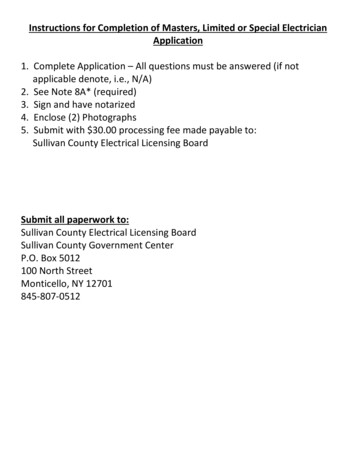

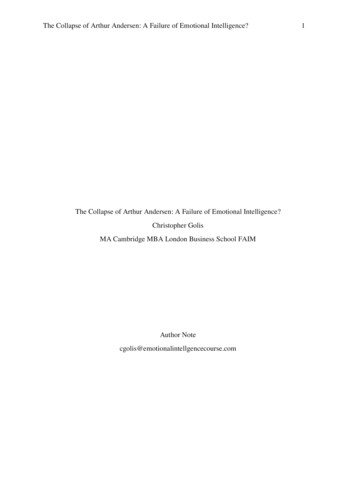
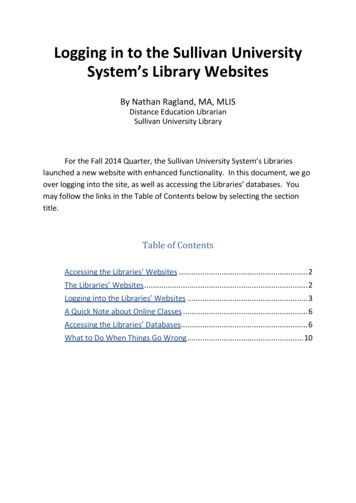
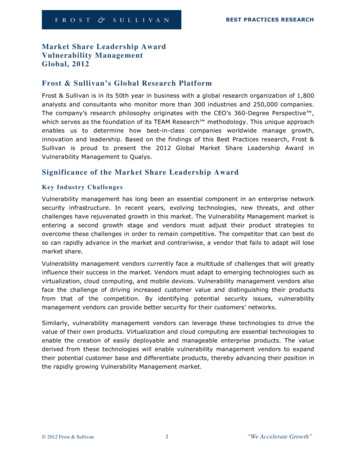
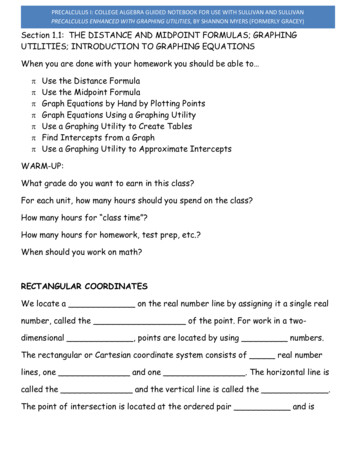

![2017 [CLIC] Attendee List - California Lodging Investment Conference](/img/59/2017-clic-attendee-list.jpg)
